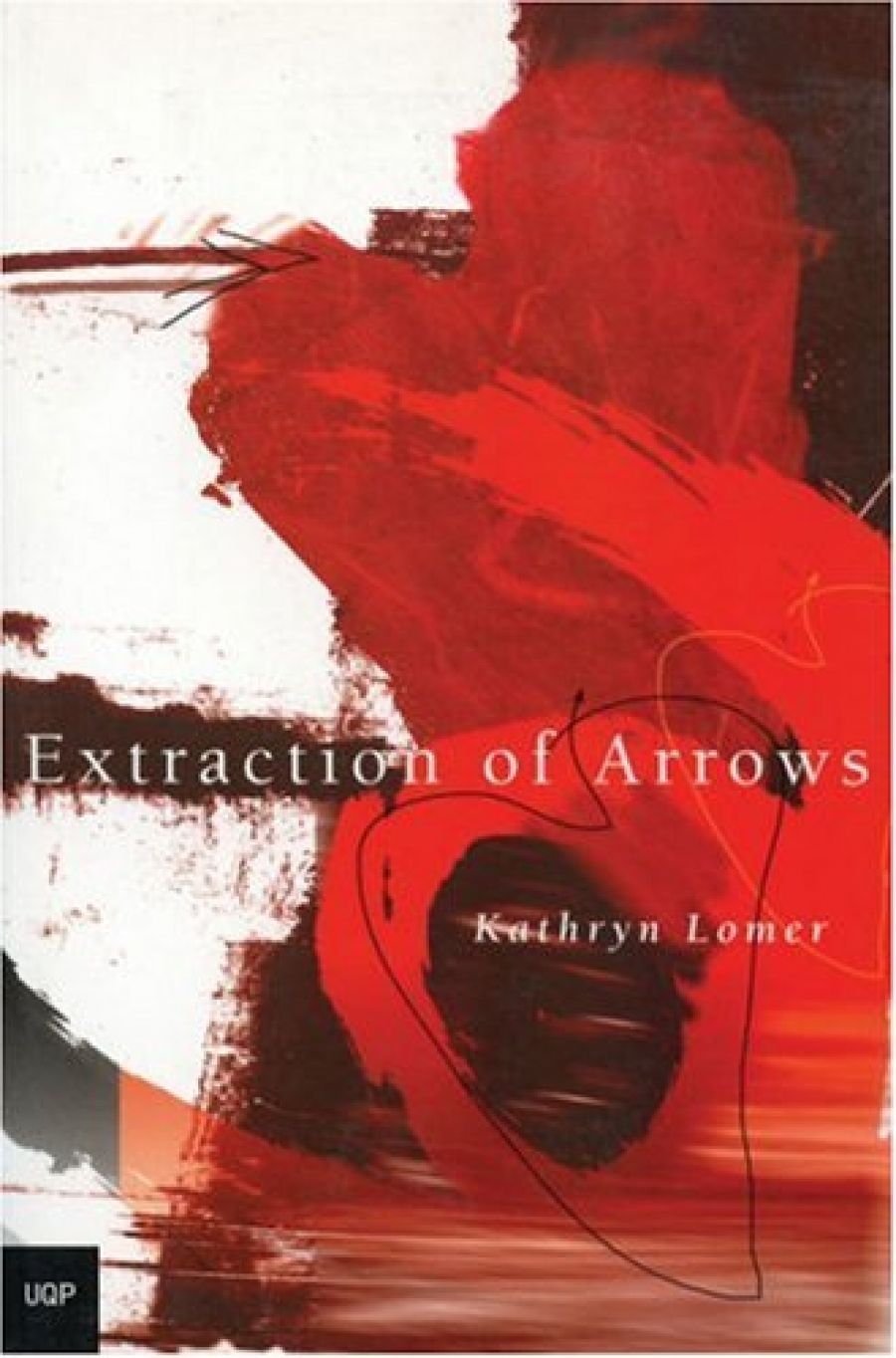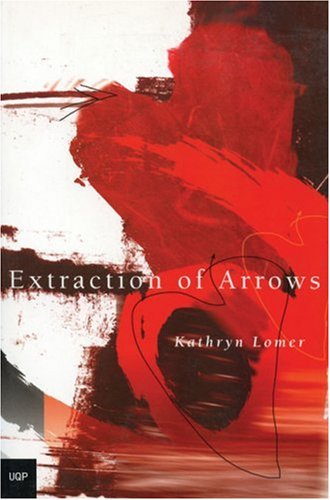
- Free Article: No
- Custom Article Title: Arbitrary Horrors
- Review Article: Yes
- Article Title: Arbitrary Horrors
- Online Only: No
- Custom Highlight Text:
Kathryn Lomer’s Extraction of Arrows is a fine first book. It is more unified than most, but with a varied enough poetic base to make one interested in the poems that Lomer will write in the future. Its essential feature is a tight focus on the self; as lyric poetry should be, it is ‘self-centred’, without any of the pejorative overtones of that phrase. At almost all points, we are aware of the poet herself, a body existing alongside a compendium of moods, experiences and emotions. It is a carefully observed body, especially in a poem such as ‘Linea Nigra’, which begins:
- Book 1 Title: Extraction of Arrows
- Book 1 Biblio: UQP, $22 pb, 67 pp
- Book 1 Cover Small (400 x 600):

- Book 1 Cover (800 x 1200):

An indigo line from extruded navel to pubis,
a narrow neat bruise or a compass line tattoo.
Beneath it, abdominal muscles asunder, uncleaved
like cheeks of a gravid peach. Above it, livid striae
of a sun-dried gourd-skin, verandahed
by mooning breasts bearing tracery of river deltas.
This is description based on intense and brilliant observation, and if the poem doesn’t continue as well as it begins (‘Stigmata of female crucifixion … the aegis of oestrogen’), we can still feel the power of that focused description. Some of the best poems are about pregnancy, childbirth and child-rearing; they gain their power from the way they reflect the strange process whereby one self makes another self out of its body. The child makes appearances regularly throughout the last two sections of the book, perhaps most interestingly in ‘Connolly’s Beach’, where child and mother watch soldier crabs disappear into their holes:
A sun-hatted face opens into mine,
unsorted emotions loose in all its parts
at these unheralded disappearances.
Later, when they meet en masse,
he whimpers at the unknown
and stands, arms crooked to the sky,
crying till I reach him.
Today he learns the words for the feeling
before and after.
If self and child are a kind of ground zero of this poet’s attention, the other figures appearing in the poems can be organised in terms of their distance from that centre. At the next ring out, so to speak, from self and child are lovers. These are either ever-present experiences (‘My best days are when I don’t see you and / my worst days are when I don’t see you’) or actual characters who, in ‘Prodigal Lover’, turn up unexpectedly after a fifteen-year absence. Beyond the lovers are the family, characters whose relation to the self is genetic. These make up some memorable portraits: ‘Limerick’s Sons’, ‘Memory Map’ and ‘A Little Extra Money’ are fine poems of quirkily distinct people. They are not objective renderings, however, since the self of the poet – their genetic inheritor – must always stand just to the side of the picture. In a way, these poems might be as personal as ‘Linea Nigra’.
All this makes the reader interested in those poems in which the self’s ‘stake’ in the situation is not apparent. ‘Ifs & Ands’ describes the experience of a woman who, with her son, survives a car accident only to find that ‘an innocent gob of chewing gum’ has prevented the oxygen administered in the ambulance from reaching the boy’s lungs: ‘two hypoxic minutes rob him of his past.’ The connection here seems clear; the poet with the baby son experiences something of the horrors that haunt all parents as possible futures by empathetically relating the story of another, older parent.
‘Squid Fisher’, a portrait from early in the book, begins with objective and subtle observation of another (‘you tug your line / with a beaked wedding finger’), but describes an almost erotic process, whereby the observing writer is seduced by her own observations.
Thus, perhaps, it will come as no surprise when I say that the poems that stay with me after several rereadings are not those that are necessarily the best written but those where the world outside the poet comes calling – and calling with a vengeance. In ‘The Freedom’, we are, at first, deluged with the poet’s situation: a love affair has collapsed, and she boards the bus from the new Slovak Republic to Vienna to see the paintings of Klimt. She meets a traveller going to visit a girl he should have married but who managed to escape the old Czech régime. The man, unable to escape, is now married with three children. Although the poem is probably trying to balance the situations of poet and traveller, it is hard not to feel that the man’s anguished story eventually rides over the top of the narrator’s miseries.
In ‘Kinsale’, something similar occurs; we begin in Ireland with familiarly insistent details of the poet’s situation:
I am flotsam here
amid the virtuosity of seagulls. I am alone,
walking with my lover whose absence is denser
than his presence was …
In the background hovers the figure of the host of the place where she is staying (‘Paddy McIntee, the owner of a shaggy body / and bull neck’). The poem goes on to deal with various observations, literary gossip and a woman traveller with whom the poet takes up. But it finishes with the pair discovering a tombstone to the wife and four children of Paddy McIntee, all lost at sea. It is when the world comes calling with its arbitrary horrors that these poems of the self are challenged, and it is an achievement of this book that it allows such challenges into the fabric of the poems.


Comments powered by CComment